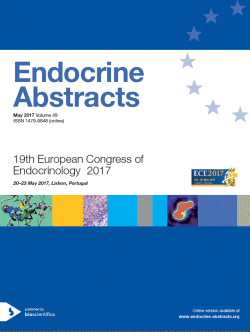Searchable abstracts of presentations at key conferences in endocrinology

19th European Congress of Endocrinology
Lisbon,
Portugal
20 May 2017 - 23 May 2017
20-23 May 2017, Lisbon, Portugal
Further information
Symposia
Hyperandrogenism: challenges in clinical management
ea0049s18.1 | Hyperandrogenism: challenges in clinical management | ECE2017
Hyperandrogenic states: pitfalls in diagnostic approach
Measuring total testosterone level is the first line approach to assess androgen excess in women. Most laboratories in Europe use direct testosterone immunoassay without prior extraction. In the near future, liquid chromatography coupled with tandem mass spectrometry (LC-MS/MS) will be commonly used for measuring testosterone, providing the best accuracy with low limit of detection. In all cases, testosterone norms must be standardized for normal premenopausal women values. Wh...
ea0049s18.2 | Hyperandrogenism: challenges in clinical management | ECE2017
Metabolic perspectives for the non-classical CAH (NCAH)
Congenital adrenal hyperplasia (CAH) is one of the most common autosomal recessive inherited endocrine diseases and is characterized by complete or partial impairment of adrenal steroidogenesis. 21-hydroxylase deficiency and 11β-hydroxylase deficiency account for 90% and 68% of cases of CAH, respectively. NCAH is the mild form of CAH and occurs in approximately 0.10.2% in the general population. The worldwide prevalence of NCAH among hyperandrogenic women is a...
ea0049s18.3 | Hyperandrogenism: challenges in clinical management | ECE2017
Hyperandrogenism and cardiometabolic risk
Hyperandrogenism is the main characteristic of PCOS therefore hyperandrogenism in women is best addressed when studying this highly prevalent syndrome. Besides the clinical features of oligomenorrhea, hirsutism and infertility, PCOS patients are often insulin resistant (IR), obese, they have arterial hypertension, dyslipidemia, an increased pro-thrombotic state, impaired glucose tolerance or frank type 2 diabetes (T2D). The prevalence of metabolic syndrome is doubled as compar...



